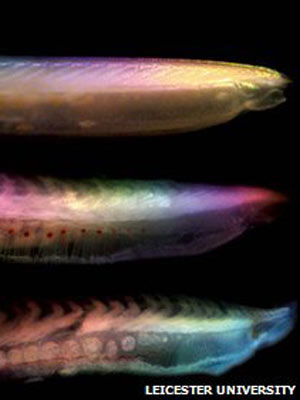Rotten fish used to study fossils
By observing the fish as they are decaying, scientists have discovered patterns that may shed light on some of the most important and ancient fossils.

Scientists examine the change of organisms when it decays.
Ocean creatures are the earliest creatures to appear on earth, they only have live strings, not skeletons. In some special cases, they are still fossilized and preserved. But all that remains in fossils is just unformed soft tissue.
What researchers want to find out is exactly how these animals change after they die and before they fossilize.
'Smelly' research with these decaying fish reveals how primitive marine organisms change as they decompose. And based on these rotting patterns, scientists can recreate marine life at birth.
The study was published in Nature.
Dr. Rod Sansom of the University of Leicester, UK, who led the study, said the same fossil test is analytical - putting together scientific theories about what had happened in the past. The only difference is that we are dealing with life millions of years ago.
Dr Mark Purnell said scientists have conducted very . unpleasant experiments. He and his colleagues studied several primitive vertebrate marine animals, including rocky grouper. They also examined a few close relatives of vertebrates.
Scientists place dead creatures in clean containers and observe each organism's change as it dies. Many distinct features - some of which biologists use to identify fossils, like muscle shape - have changed in nature when decayed.
Following these changes, scientists can form transformations to elucidate the shape of ancient marine life. This is necessary to place the organism in the right place in the tree of life.
He concluded, although this work did not make anyone interested, but it is worth the effort of scientists.
- Why is the fish rotten
- Specialty of rotten fish heads who hardly dares to eat in Alaska
- The evolutionary relationship between a fish fossil 400 million years old and humanity
- Fossils of 50 million years of the ancient fish herd nearly 300 children
- Discovering fossil fish fossils 152 million years
- Fossil discovery of an ancient round fish
- Sea dragon fossils dominate the Jurassic ocean
- Mexico found fossil fish dating back 110 million years
- Excavating fish fossils 429 million years old
- Video: Fishery cemetery in Chile
- Discover the earliest carnivorous fish, live with dinosaurs
- French people stunned because of rotten clouds
 Discovered an ancient centipede fossil 99 million years old
Discovered an ancient centipede fossil 99 million years old Discovered bat-like dinosaurs in China
Discovered bat-like dinosaurs in China Discovered a 200-year-old bronze cannon of the coast
Discovered a 200-year-old bronze cannon of the coast Discover 305 million-year-old spider fossils
Discover 305 million-year-old spider fossils